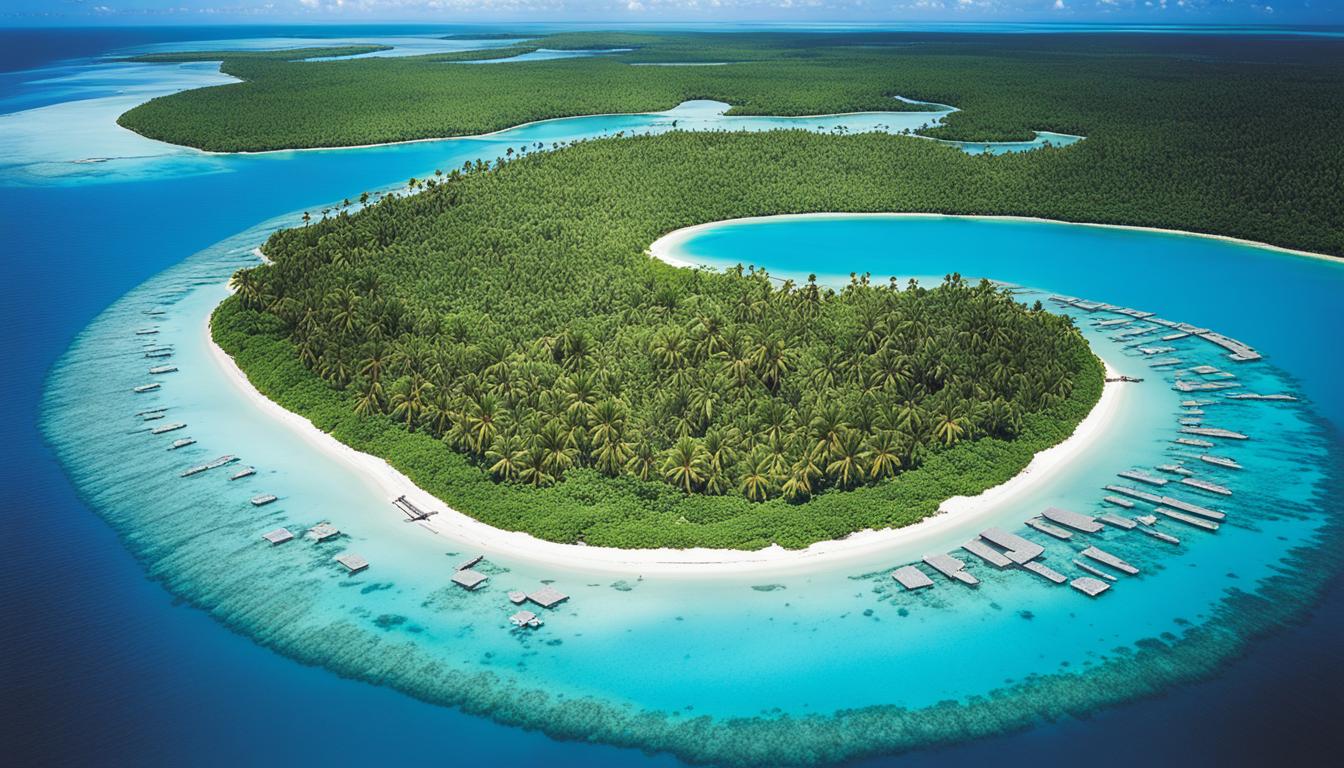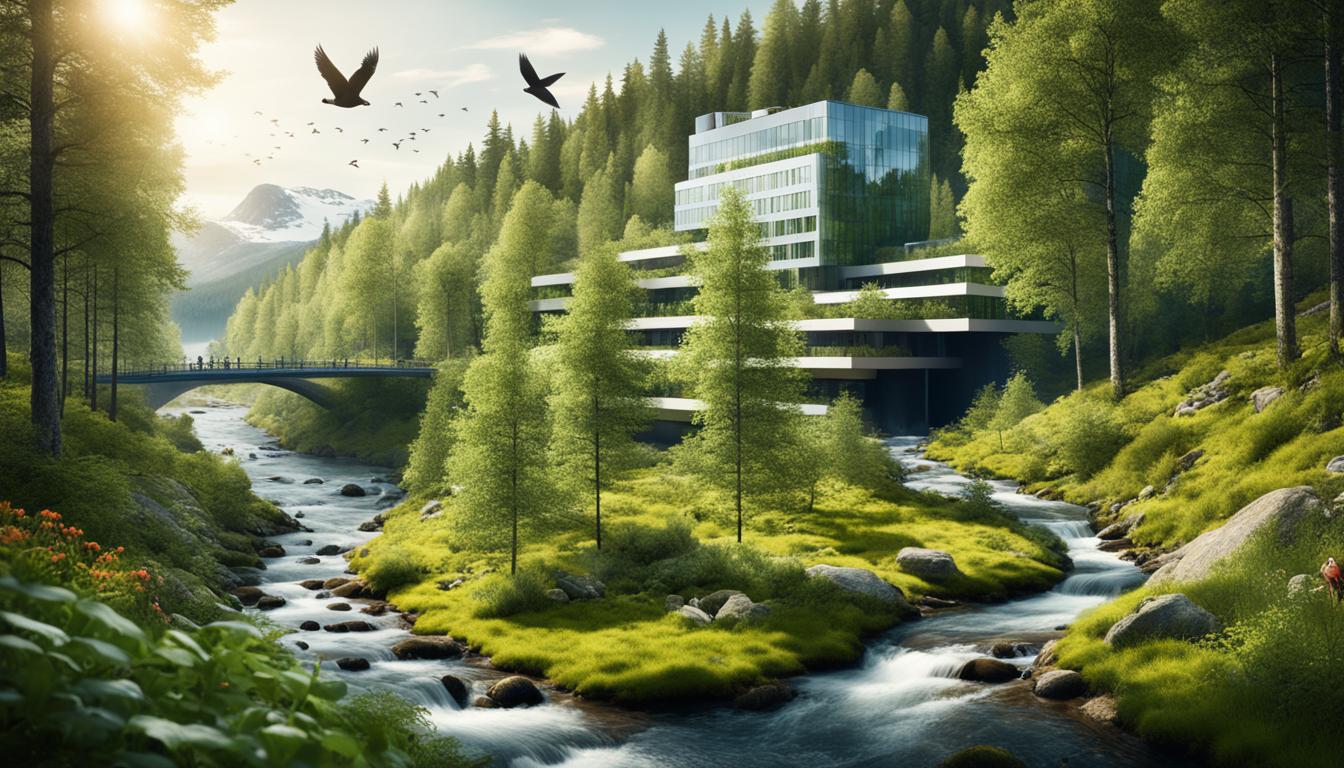Latvia Biodiversity and the Built Environment
Did you know that Latvia has the highest forest coverage among OECD countries? With its diverse ecosystems and rich natural heritage, Latvia plays a crucial role in biodiversity preservation efforts. However, the conservation status of habitats and species in Latvia is declining, highlighting the need to integrate environmental conservation into urban planning initiatives and sustainable architecture. In this article, we will explore the importance of green infrastructure design, ecological urbanism, and sustainable construction practices in Latvia’s efforts towards creating green cities and conserving its biodiversity.
Key Takeaways:
- Latvia has the highest forest coverage among OECD countries.
- The conservation status of habitats and species in Latvia is declining.
- Integrating green infrastructure design and sustainable architecture is crucial for biodiversity preservation.
- Latvia’s urban planning initiatives are focused on creating green cities and promoting ecological urbanism.
- Sustainable construction practices play a vital role in conserving biodiversity and achieving sustainable development in Latvia.
The State and Trends of Biodiversity in Latvia
Latvia is blessed with diverse ecosystems, including lush forests, expansive grasslands, vital wetlands, and captivating coastal areas. These habitats serve as critical homes for a wide array of species, many of which hold international significance. However, the conservation status of these habitats and species in Latvia is showing concerning signs of decline. The conservation efforts currently in place do not adequately encompass the needs of biodiversity, resulting in a pressing call for action.
Forests cover a staggering 54% of Latvia’s land area, with natural forests accounting for a vast 82% of the total forested area. These majestic forests provide numerous essential ecosystem services, such as offering habitats for various species, acting as carbon sinks by sequestering carbon dioxide, and playing a vital role in water regulation. Despite their immense value, intensive forest management practices have led to the replacement of ancient forests with younger ones, thereby negatively impacting the biodiversity that relies on mature ecosystems.
Grasslands are among the most diverse and richest habitats in Latvia. Regrettably, the coverage of these valuable grassland ecosystems has significantly decreased due to the relentless expansion of agricultural land. This encroachment on grasslands is leading to habitat fragmentation, affecting the viability of numerous species that rely on these unique environments.
Wetlands, including bogs and peatlands, harbor an extraordinary amount of biodiversity. Unfortunately, many of Latvia’s wetlands have suffered from drainage and extensive peat extraction. These harmful practices have damaged the delicate balance of these ecosystems, threatening the survival of countless species that depend on wetland habitats.
Latvia’s inland waters, such as rivers and lakes, teem with a rich variety of species. However, these vital water bodies face vulnerability due to various forms of pollution, as well as the transboundary impacts they encounter. Pollution poses a significant threat to the diverse aquatic ecosystems, necessitating urgent measures to mitigate its detrimental effects.
The coastal and marine areas of Latvia are vibrant hubs of life, playing host to a diverse range of habitats and species. Yet, habitat degradation, habitat loss, and the invasion of non-native species present formidable challenges to the survival of these coastal ecosystems. Swift action is essential to reverse the damage and preserve the unique coastal biodiversity of Latvia.
Key Facts about Biodiversity in Latvia
| Habitat | Conservation Status |
|---|---|
| Forests | Negative impact from intensive management |
| Grasslands | Significant decline due to agricultural land expansion |
| Wetlands | Affected by drainage and peat extraction |
| Inland waters | Vulnerable to pollution and transboundary impacts |
| Coastal and marine areas | Threatened by habitat degradation, loss, and invasive species |
It is evident that urgent conservation efforts are required to safeguard Latvia’s incredible biodiversity. Protecting and restoring forests, halting the encroachment on grasslands, reviving damaged wetlands, reducing pollution in inland waters, and implementing measures to combat habitat degradation in coastal and marine areas are all crucial steps towards preserving the rich tapestry of life that exists in Latvia’s diverse ecosystems.
Conservation Status of Habitats and Species in Latvia
The conservation status of habitats and species in Latvia is of great concern and shows a continuous decline. According to the EU Habitat Directive, only 10.5% of all habitats in Latvia have a favorable conservation status, while a staggering 51% are considered unfavorable or bad. Among the habitats with the worst conservation statuses are forests, grasslands, and peatlands. The situation is equally troubling for species, with only around one-third having a favorable status. This means that a significant number of species are at risk. In fact, threatened species make up 2% of all species in Latvia. While Latvia boasts a diverse bird population, encompassing numerous breeding and wintering species, the conservation status of breeding species remains stable for only 22% of the population. These figures underline the urgent need for stronger efforts in biodiversity conservation.
“The conservation status of habitats and species in Latvia is alarming and calls for immediate action. It is crucial that we prioritize the protection and restoration of our forests, grasslands, wetlands, and other vital ecosystems. By doing so, we can ensure the survival of our diverse species and preserve Latvia’s rich natural heritage for future generations.” – Dr. Anna Ozolina, Environmental Biologist
In order to understand the gravity of the conservation status in Latvia, let’s take a closer look at some key habitats and their current conditions:
| Habitat | Conservation Status |
|---|---|
| Forests | Unfavorable |
| Grasslands | Unfavorable |
| Wetlands | Unfavorable |
| Peatlands | Unfavorable |
As seen in the table, forests, grasslands, wetlands, and peatlands are among the habitats with the poorest conservation statuses in Latvia. This highlights the urgent need for targeted conservation efforts to restore and protect these essential ecosystems.
The conservation status of species in Latvia is equally troubling. Here is an overview of the current situation:
| Species | Conservation Status |
|---|---|
| Total Species | 2% |
| Favorable Status | 33% |
| Threatened Species | 2% |
These figures demonstrate that the conservation status of species in Latvia is a matter of grave concern. Only a third of species have a favorable status, with a significant proportion classified as threatened. This emphasizes the urgent need for comprehensive conservation measures to protect and restore biodiversity in Latvia.
It is clear that the conservation status of habitats and species in Latvia is critical. By implementing targeted conservation strategies, we can work towards reversing the decline and ensuring the long-term survival of Latvia’s diverse ecosystems and species.
Policy Framework for Biodiversity Conservation in Latvia
Latvia has established several policy documents to guide and support biodiversity conservation efforts. These policies outline key objectives and strategies to ensure the sustainable development and preservation of the country’s natural capital.
The National Development Plan 2014-2020 places a strong emphasis on maintaining natural capital for sustainable economic growth. It recognizes the importance of responsible resource use and advocates for the sustainable management of Latvia’s natural resources.
The Sustainable Development Strategy of Latvia until 2030 acknowledges the value of green corridors and seeks to preserve and restore the country’s natural capital. This strategy recognizes the vital role that such corridors play in connecting fragmented habitats, promoting biodiversity, and supporting ecological resilience.
The National Biodiversity Programme focuses on the conservation of traditional landscape structures, sustainable agriculture, and the establishment of protected areas in coastal waters. This program aims to safeguard Latvia’s unique biodiversity and ensure its long-term sustainability.
The Riga Development Programme specifically addresses the need to protect and strengthen green infrastructure within the city of Riga. This program encompasses various measures and initiatives aimed at preserving and enhancing urban biodiversity and promoting sustainable development.
These policy frameworks create a solid foundation for integrating biodiversity objectives into various sectors and promoting sustainable development in Latvia. By aligning strategies and actions with these policies, the country can effectively manage and conserve its diverse ecosystems and species.
Implementation of Green Infrastructure in Latvia
In Latvia, the implementation of green infrastructure plays a vital role in biodiversity conservation and sustainable development. Various initiatives across the country are aimed at improving the natural environment and enhancing the quality of life for both humans and wildlife.
1. Natura 2000 Sites
A key aspect of green infrastructure in Latvia is the establishment and management of Natura 2000 sites. These sites cover 11.5% of the national land area, providing protected areas for numerous species and habitats of European importance. Natura 2000 sites contribute significantly to the conservation and restoration of biodiversity in Latvia.
2. Forest Conservation
The forestry sector in Latvia recognizes the ecological importance of forests and actively works to prevent fragmentation and ecological degradation. Forests in Latvia serve multiple functions, including carbon sequestration, habitat provision, and water regulation. By implementing sustainable forest management practices, Latvia aims to maintain the integrity and biodiversity of its forest ecosystems.
3. Urban Green Spaces
Green infrastructure initiatives in urban areas, such as the establishment of green corridors in Liepaja city, aim to improve green spaces and accessibility for residents. These initiatives enhance the urban environment, promote biodiversity, and provide valuable recreational opportunities for communities.
4. Restoration of Coastal Habitats and Rivers
Another significant aspect of green infrastructure implementation in Latvia is the restoration of coastal habitats and rivers. Coastal areas serve as critical habitats for various species and are vulnerable to habitat degradation. Restoration efforts focus on preserving and rehabilitating these habitats to protect biodiversity and maintain the coastal ecosystem’s ecological balance. For example, the restoration of the Norina river aims to improve its ecological function and enhance its role in supporting biodiversity.
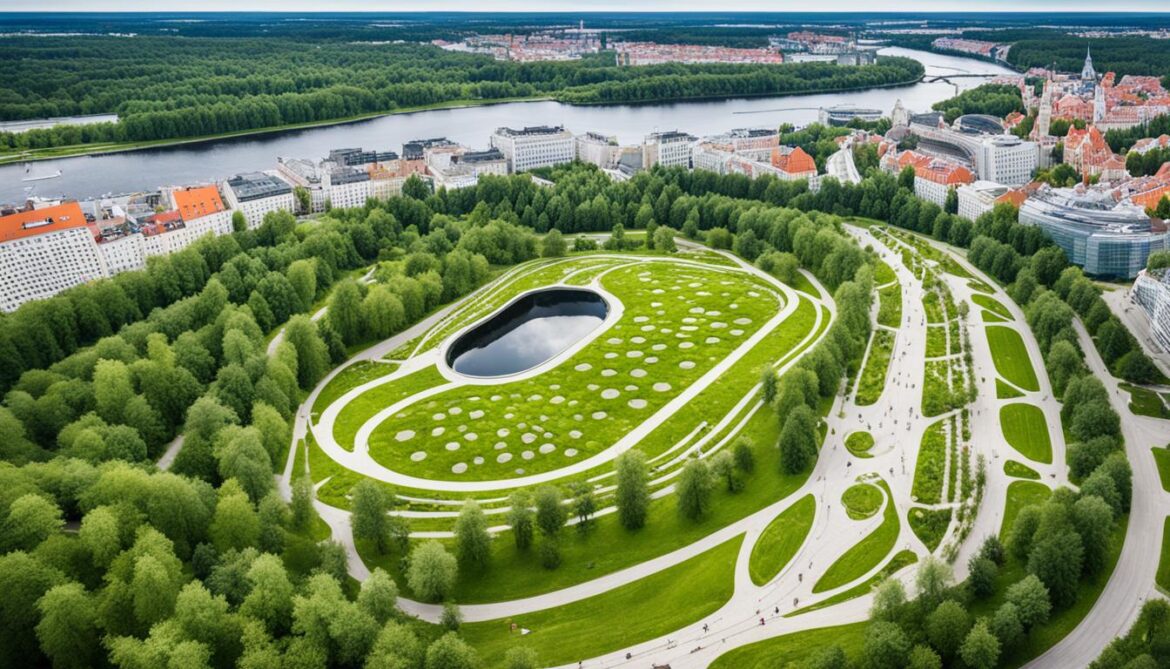
These initiatives demonstrate Latvia’s commitment to integrating green infrastructure into its landscapes, benefiting both people and nature. By conserving and enhancing the natural environment, Latvia strives to create a sustainable future for all.
Financing Green Infrastructure in Latvia
Green infrastructure in Latvia is supported by various funding sources, including public-private partnerships and financial assistance from the European Union (EU). One of the key organizations responsible for managing funding in this domain is the Ministry of Environmental Protection and Regional Development.
To secure the necessary financial resources, the Ministry operates the Environmental Protection Fund, which is sustained through taxes on natural resources. This fund plays a vital role in supporting green infrastructure initiatives throughout the country, enabling the implementation and maintenance of projects that enhance environmental sustainability.
Additionally, EU funds, such as the European Regional Development Fund, provide crucial financial support for green infrastructure projects in Latvia. These funds are instrumental in driving the development of sustainable and eco-friendly infrastructures across the country.
The availability of diverse funding mechanisms, including public-private partnerships and EU funds, promotes collaboration between the public and private sectors and boosts the implementation of green infrastructure initiatives. By harnessing these financial resources, Latvia can continue to prioritize the development of sustainable and environmentally conscious projects.
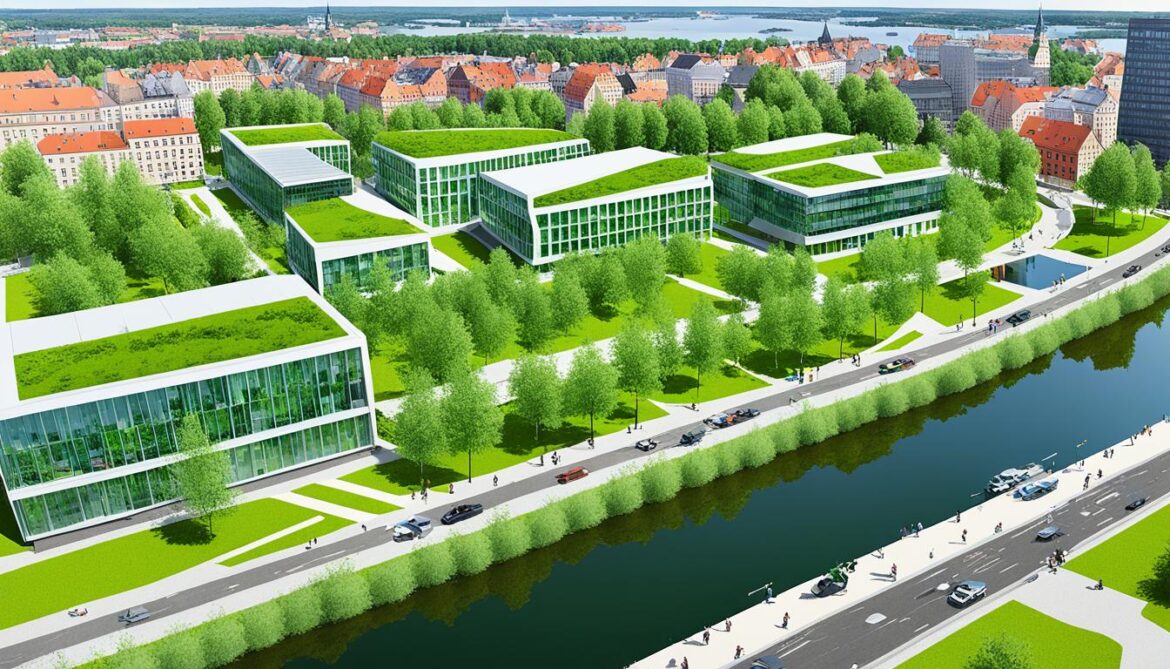
Benefits of Financing Green Infrastructure in Latvia
Funding for green infrastructure in Latvia brings numerous benefits to both the environment and society. Here are some key advantages:
- Environmental conservation: Investing in green infrastructure allows for the preservation of natural habitats, protection of biodiversity, and the mitigation of climate change impacts. It supports the restoration of ecosystems and enhances their resilience to environmental pressures.
- Economic growth and development: Green infrastructure projects stimulate economic activity by creating jobs in sectors such as construction, renewable energy, and sustainable land management. It attracts investment and contributes to the long-term sustainability of the economy.
- Social well-being: Green infrastructure provides numerous benefits to communities, including improved air quality, reduced urban heat island effects, and enhanced access to recreational spaces. It contributes to the overall health and well-being of residents.
- Resilience to climate change: Green infrastructure plays a significant role in climate change adaptation and mitigation. It helps manage stormwater, prevents floods, and reduces the vulnerability of urban areas to extreme weather events.
Examples of Successful Green Infrastructure Projects in Latvia
| Project | Description |
|---|---|
| Nature Park Development in Jurmala | A collaborative effort between the municipality and private investors to transform abandoned industrial areas into a nature park. The project involved the restoration of wetlands, creation of walking trails, and the establishment of wildlife habitats. |
| Riga Bike Network Expansion | The expansion of the Riga bike network to promote sustainable transportation and reduce carbon emissions. The project involved the construction of new bike lanes, bike-friendly infrastructure, and the implementation of a bike-sharing program. |
| Energy-Efficient Building Renovation in Liepaja | A public-private partnership aimed at renovating residential buildings in Liepaja to improve energy efficiency. The project included the installation of insulation, energy-efficient windows, and the integration of renewable energy sources. |
These successful projects showcase the positive impact of financing green infrastructure in Latvia and highlight the potential for further sustainable development in the country.
Challenges and Opportunities for Green Infrastructure Development in Latvia
Despite the progress made in implementing green infrastructure in Latvia, there are still challenges and opportunities for further development. One of the main challenges is the lack of a general strategic framework for green infrastructure policy development. Without a clear roadmap, it becomes difficult to prioritize and coordinate efforts to create a sustainable and interconnected green infrastructure network.
“A well-defined strategic framework is essential for guiding effective green infrastructure development in Latvia,” says Dr. Anna Petrova, an environmental policy expert. “It provides a shared vision and direction, allowing stakeholders to align their actions towards common goals.”
There is also a need for increasing awareness and public participation, especially at the municipal level. Many residents are unaware of the benefits of green infrastructure or the role they can play in its development. Public participation is crucial for fostering a sense of ownership and ensuring that green infrastructure projects meet the needs and aspirations of the communities they serve.
To address these challenges, Latvia has unique opportunities to enhance green infrastructure development. One such opportunity is the establishment of an inter-sectoral coordination mechanism. This would bring together representatives from various sectors, including urban planning, transportation, and environmental protection, to collaborate on green infrastructure initiatives. By pooling resources and expertise, these cross-sector partnerships can facilitate the integration of green infrastructure into different aspects of development.
Furthermore, improving know-how in green infrastructure planning and implementation is vital for successful development. By investing in capacity-building programs and knowledge exchange platforms, Latvia can equip professionals with the skills and expertise needed to design, construct, and manage green infrastructure projects effectively. This would enable the country to leverage its natural assets and maximize the benefits of green infrastructure for biodiversity conservation and sustainable development.
Opportunities for Green Infrastructure Development in Latvia
- Establishing a comprehensive strategic framework
- Enhancing awareness and public participation
- Creating an inter-sectoral coordination mechanism
- Improving knowledge and expertise in green infrastructure planning and implementation
By seizing these opportunities and addressing the challenges, Latvia can pave the way for sustainable green infrastructure development. With an inclusive strategic framework, increased awareness, and strong public participation, Latvia can create a green infrastructure network that enhances biodiversity, improves urban livability, and supports the well-being of its citizens.
| Challenges | Opportunities |
|---|---|
| Lack of a general strategic framework | Establishing a comprehensive strategic framework |
| Low awareness and public participation | Enhancing awareness and public participation |
| Creating an inter-sectoral coordination mechanism | |
| Improving knowledge and expertise in green infrastructure planning and implementation |
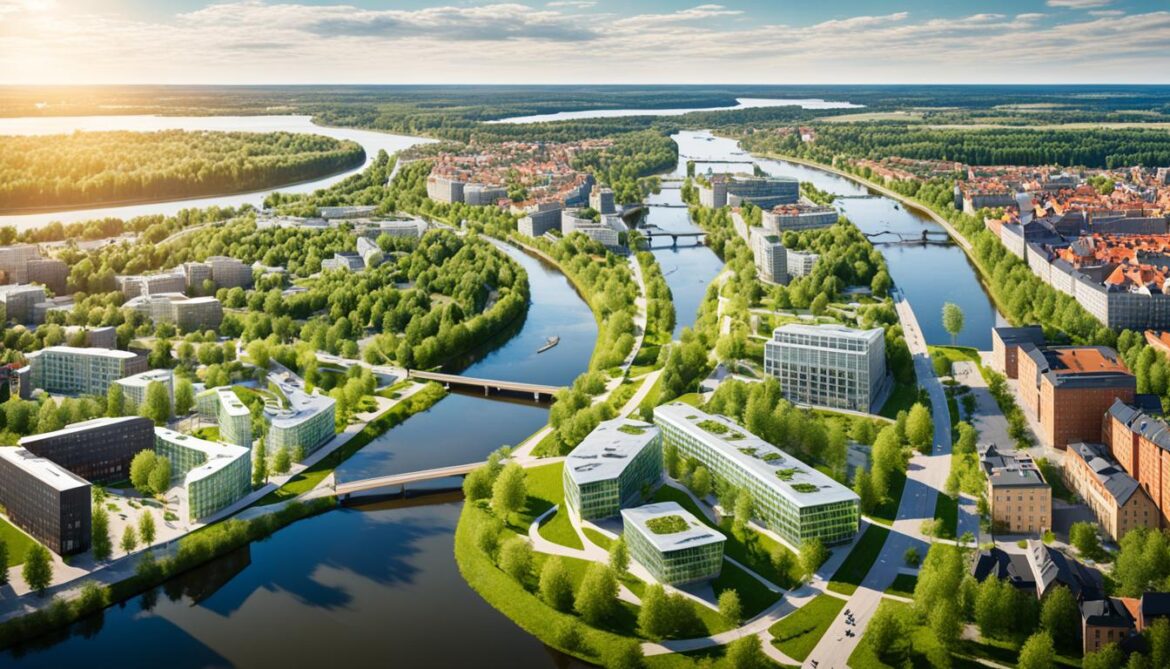
Conclusion
Latvia’s green infrastructure plays a vital role in both conserving biodiversity and promoting sustainable development. The close relationship between Latvia’s biodiversity and built environment underscores the importance of integrating green infrastructure into urban planning. Despite challenges such as land-use change and habitat degradation, there are numerous opportunities for further enhancing green infrastructure development.
By prioritizing nature conservation and integrating biodiversity objectives into various sectors, Latvia can effectively work towards its goals of preserving biodiversity and achieving sustainable urban expansion. It is crucial to raise awareness and involve the public in these efforts, ensuring that the whole community is actively engaged in biodiversity conservation.
Green infrastructure serves as a key component in creating resilient and vibrant cities, fostering biodiversity, and improving the well-being of Latvia’s population. Through strategic policy frameworks, adequate financing mechanisms, and robust public participation, Latvia can harness the potential of green infrastructure for a sustainable future.






